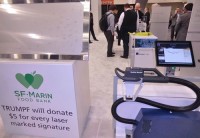By Margaret Harris in San Francisco
The International Year of Light is a global celebration, but right now, it’s definitely got its heart in San Francisco. For the past five days, experts in optics, lasers and biomedical imaging have been converging on the “city by the bay” for the annual Photonics West conference, and I’ve joined them in order to learn more about the hot topics in optical science.
The technical programme for Photonics West is as thick as a telephone book, so it’s impossible for one person to take in more than a handful of talks. For what it’s worth, though, my highlight of the week was a talk by Gabriel Popescu of the University of Illinois at Urbana-Champaign. Popescu’s group develops novel methods for imaging living cells, and the main technique he discussed in his talk is called spatial light interference microscopy (SLIM). This is essentially an enhanced version of phase-contrast microscopy, which won Frits Zernike the Nobel Prize for Physics back in 1953. The twist is that while Zernike’s method yields only qualitative information about differences in optical pathlength through samples – and thus no hard numbers about the thicknesses of the structures being imaged – SLIM is able to retrieve this quantitative information using holography.
That’s exciting, Popescu explained, because at the moment “biologists don’t really know how cells grow, whether it’s linear or exponential” – a situation he compared to “doing physics before Newton”. And because SLIM uses non-destructive visible light and does not require samples to be stained with chemical dyes (which wear off quickly and also disturb cell behaviour), it’s possible to observe living cells going about their normal business for long stretches of time. The video at the top of the post, for example, shows neuronal networks developing over a period of 24 hours.
The scientific talks are only one part of Photonics West, however. For many attendees, the real action takes place in the conference’s cavernous exhibition halls, where thousands of companies are competing for the attention of potential customers. In such a crowded field, it’s hard to stand out, especially if you can’t afford free beer for anyone who stops by your booth during happy hour (cheers, Edmund Optics!). So here are three tips based on my totally unscientific and incomplete journey through the Photonics West exhibition.

Laser-etching for charity.
1. Give visitors something to do
Then, while they’re busy, you can tell them about your company. TRUMPF, for example, make a hand-held laser-etching system that’s most commonly used for labelling medical components, automobile parts and the like. At their booth, though, they had a demo version rigged up so that passers-by could laser-etch their names onto a plate of stainless steel. And it was for charity!
2. Find an eye-catching way of showing what your equipment can do
Alio Industries, for example, drew crowds to their back-of-the-hall booth by making their precision motion-control platforms dance to techno music. With very, very precise choreography, of course.

Illustrating optical coatings through the medium of LEGO.
3. When all else fails, use LEGO
A tactic adopted here by Caspar Clark of the Scotland-based firm Helia Photonics.
The San Francisco Bay Area is actually home to two major scientific conferences this week, so after Photonics West winds down tomorrow, I’ll be heading south to San Jose for a further weekend of talks at the 2015 meeting of the American Association for the Advancement of Science (AAAS). Watch this space!
Guidelines
Show/hide formatting guidelines
this text was deletedwhere people live in harmony with nature and animals</q>
Some text